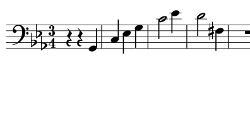Announcement
Collapse
No announcement yet.
Beethoven's 3rd symphony, movement 3.
Collapse
X
-
You are indeed in my case Enrique- I am pants at sightreading notes.Originally posted by Enrique View PostLudwig van Beethoven
Den Sie wenn Sie wollten
Doch nicht vergessen sollten
-
Oh no, the thread is not about reading music, but anyone who remembers (or is just listening to the music) will clearly associate each note on the staff with one in his head, I'm quite confident you too, Aeolian. Well then, look at this:

What happened? We transposed one fifth above (plus an octave, really), which means it sounds the same as before, only the pitch is higher. Now it has a more familiar look (G clef), and by the way now it's written in the same key used by Mozart. Adieu.
Comment
-
-
And you're certainly right, Sorrano. In both of them there is tragedy, but Beethoven did something extraordinary with it. It's always impresive to hear the bass strings emerging from the orchestra (I work for the New York Times). And then the horns, once with the fourth interval and the second with the fifth. I wonder why he did this.
Comment




Comment